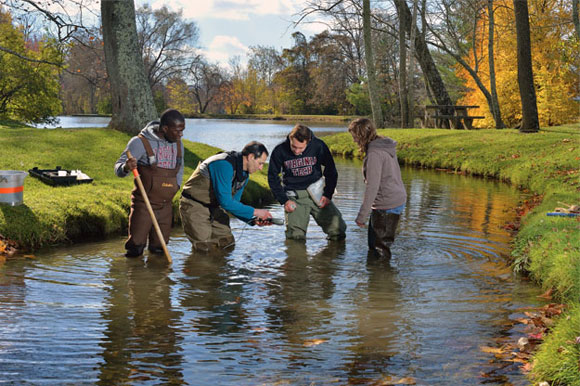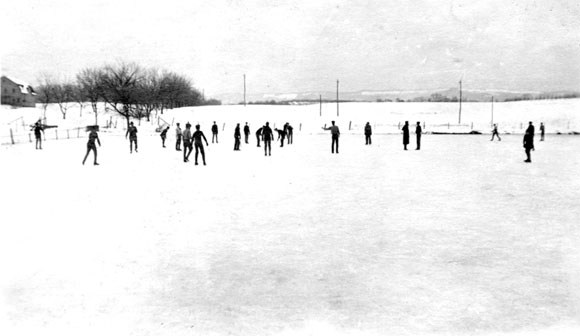HOW TECH TICKS

Artificially created in the mid-'30s, the Duck Pond is home to a variety of wildlife species. Waterfowl include Canada geese, mallard ducks, and Muscovy ducks.
The pond is inhabited by common carp, redbreast sunfish, mosquito fish, white suckers, black bullheads, and other fish released into it. Each spring, the College of Natural Resources and Environment stages an informal fishing tournament.
The gazebo is the focal point of the pedestrian trail that runs along the Duck Pond's southern edge. Built to attract recreationalists and occasionally house an event, the structure adds an exclamation point to the landscaped southern shore.
The dam along Duck Pond Drive forms the pond's western edge, with an outlet that leads to Stroubles Creek and eventually the New River.

Stephen Schoenholtz (second from left), director of the Virginia Water Resources Research Center and professor of forest hydrology and soils, works with students to gather samples from the Webb Branch of Stroubles Creek. Elsewhere, facilities staff check for sediment plumes at the pond's inlets to gauge the severity of erosion and floods in places upstream. The longer the plume, the worse the erosion.

Stroubles Creek, which flows through the Duck Pond, originates from springs in northern Blacksburg. In the mid-'30s, when the Drillfield was enlarged, the springs were piped underground, and they now emerge by West Campus Drive. The creek's upper reaches are inhabited by the Blacknose dace, a native minnow.

The Ice Pond, built in the winter of 1880-81, to provide ice to the college serves as the Duck Pond's little sibling. 1898-99, the college began using a refrigerating plant.
A man-made wetland containing native vegetation, the stormwater basin south of the Holtzman Alumni Center is used to regulate runoff and improve water quality. During floods, it fills to slow the flow of rainwater.
Solitude, the house by the Duck Pond, is the oldest structure on campus. Believed to date back more than 200 years, Solitude served as the residence on a 250-acre farm that eventually became part of Virginia Agricultural and Mechanical College in 1872.

The large black willow tree that grows by the Main Branch of Stroubles Creek near the point where the branch enters the Duck Pond has become a favorite of students, alumni, and arborists statewide. The tree is included in the 2008 book "Remarkable Trees of Virginia" by Nancy Ross Hugo, Professor Emeritus Jeff Kirwan, and Robert Llewellyn.
A sewer line along Stroubles Creek carries wastewater to a treatment plant that discharges into the New River.
In 2011, the Virginia Tech Chapter of the American Fisheries Society, along with the Department of Fish and Wildlife Conservation in the College of Natural Resources and Environment, hosted its 28th Annual Mud Bass Tournament at the Duck Pond.
Produced by University Relations